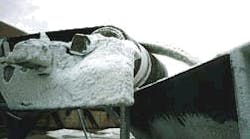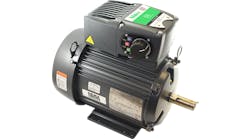Conventional external conveyor drives (belts, chains, sprockets, gearing) can be inefficient. They require frequent lubrication, are difficult to maintain and repair and tend to be noisy. If protective shrouds do not guard the open chains or belts, the drives pose a potential danger to workers. Internally powered drum motors are a good alternative when reliable and maintenance-free operation is required.
Although the technology to provide reliable, long-lasting drive systems is available, the mindset of many plant managers and system designers still is outdated. Oftentimes, these managers and designers select a conventional drive based on experience, without investigating the benefits of internally driven systems. Typically, the end result is a major investment in a new system that will exhibit the same problems as the old system it is replacing. Moreover, these problems can occur sooner because of increased performance and productivity demands.
Low-profile drum motors save valuable space in a conveyor drive configuration by eliminating the need for a separate motor, gear reducer, sprockets, chain bearings and all associated mounting hardware. In the drum motor design, all movable parts are housed within the pulley shell, making installation and replacement an easy task. The motors simply slip into place in a conveyor frame or can be installed on mounting blocks.
The drum motor's basic design includes the steel pulley shell (crowned to ensure accurate belt tracking) and an induction motor coupled to a multistage planetary gear reducer with an output that directly drives the pulley shell. The design is 30 percent to 40 percent more efficient than conventional multi-component systems because all generated horsepower is used to drive the conveyor. As a result, the drum motor has unusually high torque and power capabilities. The cooling properties of the oil bath enhance the high torque capability by allowing 35 percent to 40 percent more motor heat dissipation than conventional air-cooled designs.
The induction-type motors use windings and rotor systems capable of providing more torque to facilitate conveyor startup, even under a full load. The drum motor allows continuous operation under full-load conditions without excessive heat buildup.
A belt conveyor drive pulley with internal gearing and electric motor operates an abrasive, corrosive salt-handling application.
Drum motor details
Drum motors are ideally suited for chemical processing applications requiring nickel-plated or stainless steel components, special lubricants, lagging and seals to meet stringent U.S. Department of Agriculture (USDA) and Food and Drug Administration (FDA) sanitation requirements. The key components of a self-contained drum motor are a heavy-duty motor and gearbox. Torque is transferred from the motor through a multiple-step gear reduction unit to a final gear.
The motor rotates two-stage gearing that transmits power to the outer shell through a final gear ring fixed to the rotating shell. The motor and gears run in a completely sealed-in oil bath that ensures all moving parts are properly lubricated and cooled. One oil change is recommended every 50,000 hours of operation; the oil change can be accomplished without removing the drum motor from the conveyor.
Drum motors are available in a wide range of sizes, standard ratings and speeds. A wide variety of drum motor options exist to match specific applications. For example, rubber, urethane and metal tread laggings in smooth, diamond or chevron patterns are used to increase belt traction. Ultra-high-molecular-weight-polyethylene (UHMW-PE) sprockets can be attached to the drum motor surface to drive industry-standard plastic segmented belting. Among other options are a patented internal clutch brake for high-indexing applications and a patented manual release backstop device for incline conveyors and GV thermal overload protection.
Application examples
In the chemical industry, belt conveyors are used in a wide variety of applications. From the processing of raw materials to the packaging of cosmetics and pharmaceuticals to the distribution of agricultural chemicals and petroleum products, conveyor belts provide a simple and economical method to handle materials. The following examples are just a sampling of the applications that employ internally powered drum motors.
Pharmaceutical packaging example. In a specific pharmaceutical packaging operation, motorized drum motors initially were installed to reduce the number of conveyor drive components. However, sanitation benefits quickly were realized.
Drum motors survive harsh environment processing of raw materials in open pits or transfer stations.
Sealed-in drive components and lubricants provide a clean drive system that is washed down easily during clean-up procedures. Also, elimination of chains, sprockets and chain guards provides a safe, compact, space-saving profile with less chance for product contamination.
The pharmaceutical processor uses belt conveyors on filling lines to package pills, capsules, caplets, etc., into various sized containers. In an effort to upgrade the processing and packaging operations, it designed a compact modular conveyor system that uses either polyvinyl chloride (PVC) or polyester conveyor belting driven by a drum motor. The compact, low-profile motor eliminates all drive hardware. Conventional drives presented a contamination concern. If external components wore, metal flaking or splintering could end up in the product.
Pills and capsules are lightweight products requiring conveyors with low-horsepower motors (0.5 hp to 2.0 hp). Drum motor diameters from 4-1/2 inches (in.) to 8-1/2 in. operate the 40-foot (ft.) to 60-ft. long conveyors. The average conveyor belt width is 12 in., with speeds ranging from 70 feet per minute (fpm) to 150 fpm.
The drum motors run 24 hours a day, six or seven days a week in the production area. In the packaging area, they run 16 hours a day. Approximately 100 units are in operation. Installation and maintenance labor are reduced by an estimated 60 percent. Cleanup, which involves vacuuming the equipment, is easier because no drive chains and chain guides exist to get in the way. Also, if needed, the equipment can be hosed down with water without damaging the drive system.
Petroleum processing example. In a major automotive petroleum processing/ distribution facility, belt conveyors are used to convey case lots from the storage areas to the order-picking area and then on to the loading dock. During an average week, approximately 30 trucks are loaded, each with the capacity to haul 2,200 cases. The facility has a bank of pallet racks with 108 flow storage lanes; 64 varieties of oils and additives are stored. Each storage lane is dedicated to a specific product; certain top sellers warrant two lanes.
The front of each storage lane is a pick slot. Because pallets are loaded in the rear, the first product put into distribution is the first product shipped. A series of belt conveyors weaves through the racking structure, allowing order pickers to put specific items onto the belt. The conveyor belt must have the capacity to handle a variety of loads and must operate for extended periods. The distributor cannot afford downtime for the conveyor. The drum motor design provides a long-lasting and extremely durable drive system. Since implementing the new order picking system, the facility has experienced new records in the distribution area, shipping as many as 75,000 cases in one week.
Zander is an applications engineer with Van der Graaf Inc., Brampton, Ontario, Canada. Contact him at (905) 793-8100.


